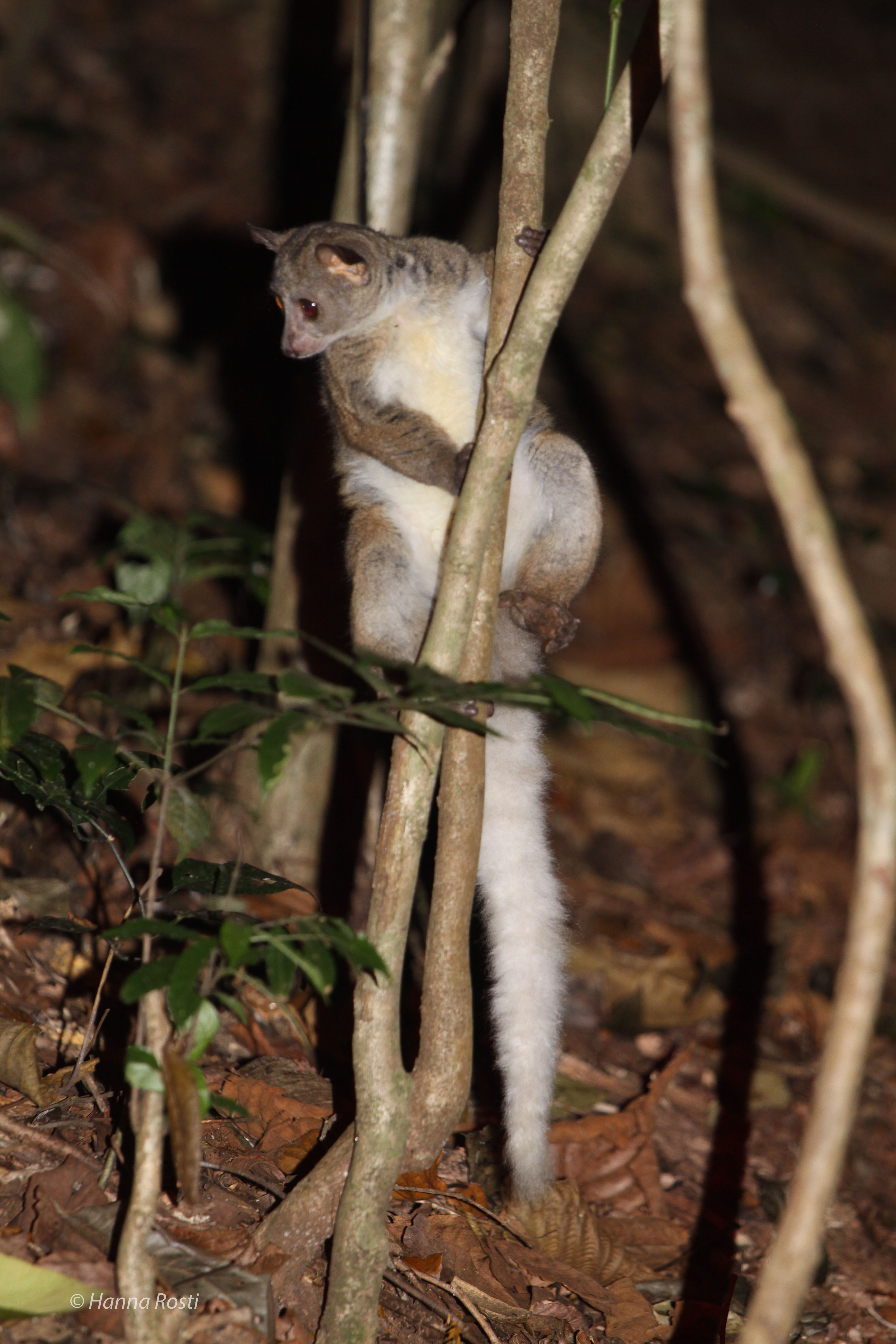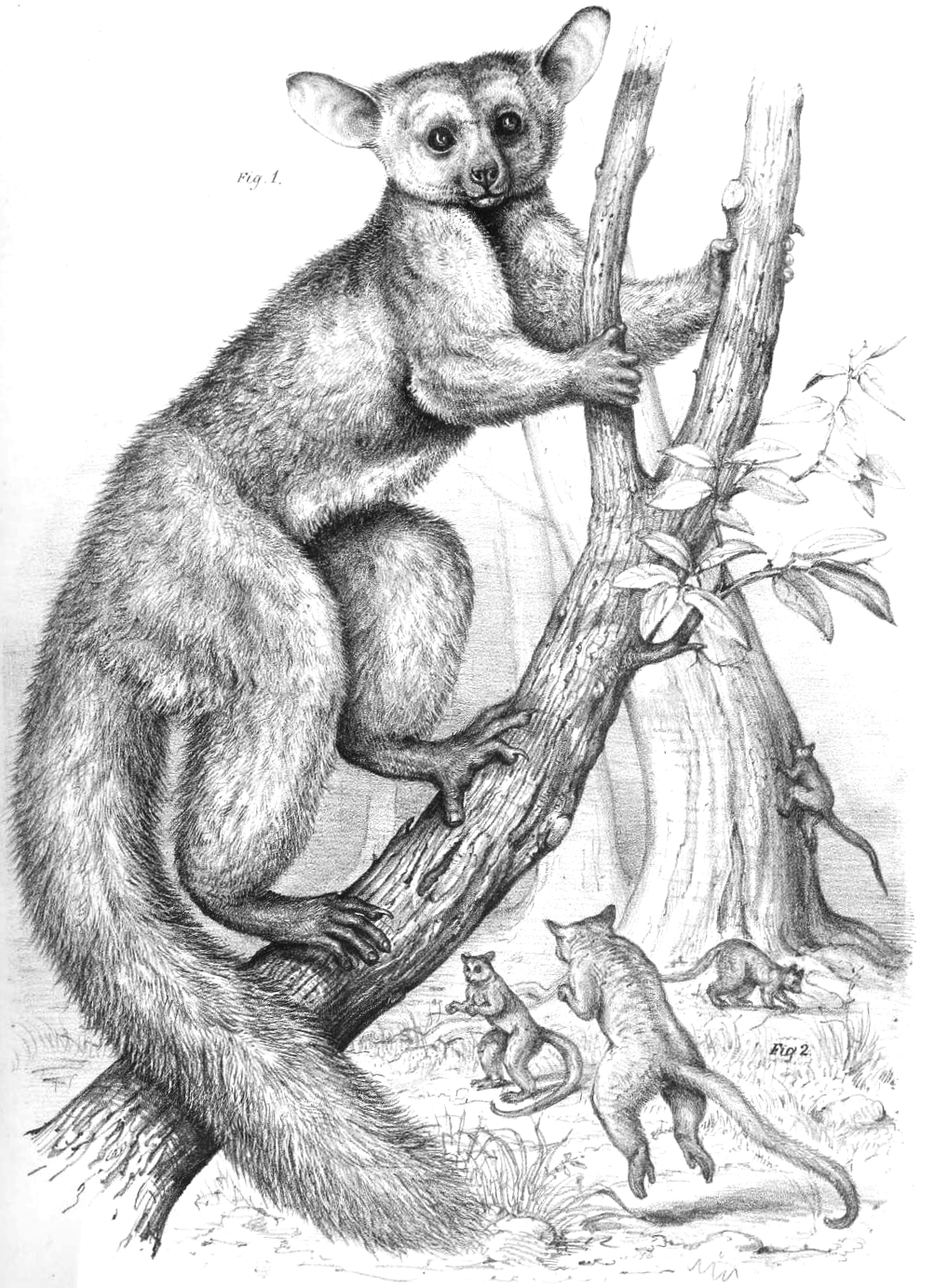|
Otolemur
The greater galagos or thick-tailed bushbabies are three species of strepsirrhine primates. They are classified in the genus ''Otolemur'' in the family Galagidae. Historical classification and species discovery The diversity of galago species has historically been grossly underestimated. In 1931, only 5 species were recognized, 4 in the genus ''Galago'' and 1 in ''Euoticus'', and only one species that would later be placed in the genus ''Otolemur''. In 1979, the genus ''Otolemur'' was separated from ''Galago''. By 1986, eleven species were recognized with revamped systemic classification including ''Otolemur crassicaudatus'' and ''Otolemur garnettii''. Additionally, ''O. crassidautus'' and ''O. monteiri'' were recognized as separate species instead of ''O. monteiri'' as a nested subspecies. By 2001, 23 species were recognized. Classification by vocalization has particularly become prevalent and helpful as a tool in understanding of these species. All ''Otolemur'' species exhibi ... [...More Info...] [...Related Items...] OR: [Wikipedia] [Google] [Baidu] |
Brown Greater Galago
The brown greater galago (''Otolemur crassicaudatus''), also known as the large-eared greater galago or thick-tailed galago, is a nocturnal animal, nocturnal primate, the largest in the family of galagos. As opposed to smaller galago species it would climb, walk or run rather than leap. Taxonomy Two subspecies of ''Otolemur crassicaudatus'' are recognised: *''O. c. crassicaudatus'' *''O. c. kirkii'' The IUCN considers the silvery greater galago as a third subspecies, ''O. c. monteiri''. Other sources treat it as a separate species, though with "misgivings". The IUCN Red List assesses all three forms individually as Least Concern. Physical characteristics This species has a rounded head with a short, wide snout, very large ears that can be moved independently and relatively large forward binocular eyes. They possess flat thickened skin pads at the ends of their fingers and toes for grasping limbs. The fingers are long and toes are flattened with flattened nails. The dentiti ... [...More Info...] [...Related Items...] OR: [Wikipedia] [Google] [Baidu] |
Northern Greater Galago
The northern greater galago (''Otolemur garnettii''), also known as Garnett's greater galago, Garnett's galago, or the small-eared greater galago, is a nocturnal, arboreal primate endemic (ecology), endemic to Africa. Subspecies Four subspecies of ''Otolemur garnettii'' are recognized: * ''Otolemur garnettii garnettii'' * ''Otolemur garnettii lasiotis'' * ''Otolemur garnettii kikuyuensis'' * ''Otolemur garnettii panganiensis'' Physical characteristics This species has a large body size relative to other galagos. The ears are small relative to the round head with short, wide snout. The eyes are large and binocular. The dentition formula is 2:1:3:3. The coloration depends upon subspecies: ''O. g. garnetti'' exhibits green-tinged reddish brown dorsal pelage. The ventral side is yellow and the terminal half of the tail is black. ''O. g. lasiotis'' has lighter and more gray toned fur than ''O. g. garnetti.'' The ventral side is white and the tail's terminal end of the tail is only sl ... [...More Info...] [...Related Items...] OR: [Wikipedia] [Google] [Baidu] |
Otolemur Crassicaudatus
The brown greater galago (''Otolemur crassicaudatus''), also known as the large-eared greater galago or thick-tailed galago, is a nocturnal primate, the largest in the family of galagos. As opposed to smaller galago species it would climb, walk or run rather than leap. Taxonomy Two subspecies of ''Otolemur crassicaudatus'' are recognised: *''O. c. crassicaudatus'' *''O. c. kirkii'' The IUCN considers the silvery greater galago as a third subspecies, ''O. c. monteiri''. Other sources treat it as a separate species, though with "misgivings". The IUCN Red List assesses all three forms individually as Least Concern. Physical characteristics This species has a rounded head with a short, wide snout, very large ears that can be moved independently and relatively large forward binocular eyes. They possess flat thickened skin pads at the ends of their fingers and toes for grasping limbs. The fingers are long and toes are flattened with flattened nails. The dentition formula is I 2/ ... [...More Info...] [...Related Items...] OR: [Wikipedia] [Google] [Baidu] |
Otolemur Garnettii
The northern greater galago (''Otolemur garnettii''), also known as Garnett's greater galago, Garnett's galago, or the small-eared greater galago, is a nocturnal, arboreal primate endemic to Africa. Subspecies Four subspecies of ''Otolemur garnettii'' are recognized: * ''Otolemur garnettii garnettii'' * ''Otolemur garnettii lasiotis'' * ''Otolemur garnettii kikuyuensis'' * ''Otolemur garnettii panganiensis'' Physical characteristics This species has a large body size relative to other galagos. The ears are small relative to the round head with short, wide snout. The eyes are large and binocular. The dentition formula is 2:1:3:3. The coloration depends upon subspecies: ''O. g. garnetti'' exhibits green-tinged reddish brown dorsal pelage. The ventral side is yellow and the terminal half of the tail is black. ''O. g. lasiotis'' has lighter and more gray toned fur than ''O. g. garnetti.'' The ventral side is white and the tail's terminal end of the tail is only slightly darker than ... [...More Info...] [...Related Items...] OR: [Wikipedia] [Google] [Baidu] |
Otolemur Monteiri
The silvery greater galago (''Otolemur monteiri'') is a nocturnal primate from the galago family. It is usually found in ''Brachystegia'' woodland, from Angola to Tanzania, western Kenya and Rwanda. The species was separated from the brown greater galago by Colin Groves in 2001. Subspecies There are two recognised subspecies. * ''Otolemur monteiri monteiri'', found in more southerly regions * ''Otolemur monteiri argentatus'', from the Lake Victoria region References {{Taxonbar, from=Q1206135 silvery greater galago Mammals of Angola Mammals of Tanzania Mammals of Kenya Mammals of Rwanda Fauna of Southern Africa silvery greater galago silvery greater galago The silvery greater galago (''Otolemur monteiri'') is a nocturnal primate from the galago family. It is usually found in ''Brachystegia'' woodland, from Angola to Tanzania, western Kenya and Rwanda. The species was separated from the brown great ... Taxobox binomials not recognized by IUCN [Baidu] |
Galagidae
Galagos , also known as bush babies, or ''nagapies'' (meaning "night monkeys" in Afrikaans), are small nocturnal primates native to continental, sub-Sahara Africa, and make up the family Galagidae (also sometimes called Galagonidae). They are considered a sister group of the Lorisidae. According to some accounts, the name "bush baby" comes from either the animal's cries or its appearance. The Ghanaian name ''aposor'' is given to them because of their firm grip on branches. In both variety and abundance, the bush babies are the most successful strepsirrhine primates in Africa, according to the African Wildlife Foundation. Taxonomic classification and phylogeny Galagos are currently grouped into six genera. ''Euoticus'' is a basal sister taxon to all the other galagids. The 'dwarf' galagids recently grouped under the genus ''Galagoides'' have been found, based on genetic data, and supported by analysis of vocalisations and morphology, to actually consist of two clades, whi ... [...More Info...] [...Related Items...] OR: [Wikipedia] [Google] [Baidu] |
Silvery Greater Galago
The silvery greater galago (''Otolemur monteiri'') is a nocturnal primate from the galago family. It is usually found in ''Brachystegia'' woodland, from Angola to Tanzania, western Kenya and Rwanda. The species was separated from the brown greater galago by Colin Groves in 2001. Subspecies There are two recognised subspecies. * ''Otolemur monteiri monteiri'', found in more southerly regions * ''Otolemur monteiri argentatus'', from the Lake Victoria Lake Victoria is one of the African Great Lakes. With a surface area of approximately , Lake Victoria is Africa's largest lake by area, the world's largest tropical lake, and the world's second-largest fresh water lake by surface area after ... region References {{Taxonbar, from=Q1206135 silvery greater galago Mammals of Angola Mammals of Tanzania Mammals of Kenya Mammals of Rwanda Fauna of Southern Africa silvery greater galago silvery greater galago Taxobox binomials not recognized by IUCN [Baidu] |
Galagos
Galagos , also known as bush babies, or ''nagapies'' (meaning "night monkeys" in Afrikaans), are small nocturnal primates native to continental, sub-Sahara Africa, and make up the family Galagidae (also sometimes called Galagonidae). They are considered a sister group of the Lorisidae. According to some accounts, the name "bush baby" comes from either the animal's cries or its appearance. The Ghanaian name ''aposor'' is given to them because of their firm grip on branches. In both variety and abundance, the bush babies are the most successful strepsirrhine primates in Africa, according to the African Wildlife Foundation. Taxonomic classification and phylogeny Galagos are currently grouped into six genera. ''Euoticus'' is a basal sister taxon to all the other galagids. The 'dwarf' galagids recently grouped under the genus ''Galagoides'' have been found, based on genetic data, and supported by analysis of vocalisations and morphology, to actually consist of two clades, whic ... [...More Info...] [...Related Items...] OR: [Wikipedia] [Google] [Baidu] |
Strepsirrhine
Strepsirrhini or Strepsirhini (; ) is a suborder of primates that includes the lemuriform primates, which consist of the lemurs of Madagascar, galagos ("bushbabies") and pottos from Africa, and the lorises from India and southeast Asia. Collectively they are referred to as strepsirrhines. Also belonging to the suborder are the extinct adapiform primates which thrived during the Eocene in Europe, North America, and Asia, but disappeared from most of the Northern Hemisphere as the climate cooled. Adapiforms are sometimes referred to as being "lemur-like", although the diversity of both lemurs and adapiforms does not support this comparison. Strepsirrhines are defined by their "wet" (moist) rhinarium (the tip of the snout) – hence the colloquial but inaccurate term "wet-nosed" – similar to the rhinaria of canines and felines. They also have a smaller brain than comparably sized simians, large olfactory lobes for smell, a vomeronasal organ to detect pheromones, and a bicornuat ... [...More Info...] [...Related Items...] OR: [Wikipedia] [Google] [Baidu] |
Charles Coquerel
Jean Charles Coquerel (2 December 1822 – 12 April 1867) was a French navy surgeon, algologist, and entomologist. Coquerel collected insects in Madagascar and neighbouring islands. A number of these were described after his death by Léon Fairmaire in his ''Notes sur les Coléopteres recueillis par Charles Coquerel a Madagascar et sur les côtes d'Afrique'' (1869). During his lifetime Coquerel wrote a number of articles and books, including an appendix on insects in Auguste Vinson's ''Voyage à Madagascar au couronnement de Radama II'' (1865). A number of animals are named after him, including the Coquerel's coua (''Coua coquereli'' Grandidier, 1867), the Coquerel's sifaka (''Propithecus coquereli'' Milne-Edwards, 1867), and the Coquerel's giant mouse lemur (''Mirza coquereli'' Grandidier, 1867), each of these species is endemic to Madagascar. Coquerel's insect collection is in the Muséum national d'histoire naturelle The French National Museum of Natural History, known in ... [...More Info...] [...Related Items...] OR: [Wikipedia] [Google] [Baidu] |
Primate
Primates are a diverse order of mammals. They are divided into the strepsirrhines, which include the lemurs, galagos, and lorisids, and the haplorhines, which include the tarsiers and the simians (monkeys and apes, the latter including humans). Primates arose 85–55 million years ago first from small terrestrial mammals, which adapted to living in the trees of tropical forests: many primate characteristics represent adaptations to life in this challenging environment, including large brains, visual acuity, color vision, a shoulder girdle allowing a large degree of movement in the shoulder joint, and dextrous hands. Primates range in size from Madame Berthe's mouse lemur, which weighs , to the eastern gorilla, weighing over . There are 376–524 species of living primates, depending on which classification is used. New primate species continue to be discovered: over 25 species were described in the 2000s, 36 in the 2010s, and three in the 2020s. Primates have large bra ... [...More Info...] [...Related Items...] OR: [Wikipedia] [Google] [Baidu] |


.jpg)


.jpg)